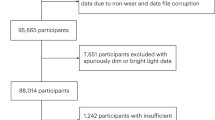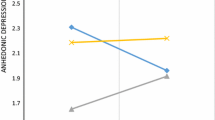Abstract
Rationale
Hyperthymic temperament is one of several premorbid temperaments putatively associated with bipolar disorder. Several reports suggest that depressive patients with hyperthymic temperament may belong to the proposed soft bipolar spectrum.
Objectives
To investigate biological aspects of hyperthymic temperament, the present study examined daily activity, sleep time, central serotonergic function, and other relevant variables in relation to hyperthymic temperament in healthy subjects.
Methods
Fifty six healthy subjects were monitored via the actigraphy system to measure daily total activity, sleep time, and illuminance. A neuroendocrine challenge test was performed to estimate central serotonergic function.
Results
Multiple regression analysis revealed that higher illuminance of daytime, greater fluctuation in sleep time, and lower central serotonergic function significantly and independently predicted hyperthymic temperament scores.
Conclusions
The present findings suggest that light, sleep, and serotonin are crucial factors in understanding hyperthymic temperament, which may be common to bipolar disorder.

Similar content being viewed by others
References
Akiskal HS (1995) Toward a temperament-based approach to depression: implications for neurobiologic research. Adv Biochem Psychopharmacol 49:99–112
Akiskal HS, Mallya G (1987) Criteria for the “soft” bipolar spectrum: treatment implications. Psychopharmacol Bull 23:68–73
Akiskal HS, Pinto O (1999) The evolving bipolar spectrum. Prototypes I, II, III, and IV. Psychiatr Clin North Am 22:517–534
Ankers D, Jones SH (2009) Objective assessment of circadian activity and sleep patterns in indivuals at behavioral risk of hypomania. J Clin Psychol 65:1071–1086
Cowen PJ (1993) Serotonin receptor subtypes in depression: evidence from studies in neuroendocrine regulation. Clin Neuropharmacol 16:S6–S18
Ehlers CL, Frank E, Kupfer DJ (1988) Social zeitgebers and biological rhythms. A unified approach to understanding the etiology of depression. Arch Gen Psychiatry 45:948–952
Even C, Schröder CM, Friedman S, Rouillon F (2008) Efficacy of light therapy in nonseasonal depression: a systematic review. J Affect Disord 108:11–23
Frank E, Hlastala S, Ritenour A, Houck P, Tu XM, Monk TH, Mallinger AG, Kupfer DJ (1997) Inducing lifestyle regularity in recovering bipolar disorder patients: results from the maintenance therapies in bipolar disorder protocol. Biol Psychiatry 41:1165–1173
Frank E, Swartz HA, Kupfer DJ (2000) Interpersonal and social rhythm therapy: managing the chaos of bipolar disorder. Biol Psychiatry 48:593–604
Golden RN, Gaynes BN, Ekstrom RD, Hamer RM, Jacobsen FM, Suppes T, Wisner KL, Nemeroff CB (2005) The efficacy of light therapy in the treatment of mood disorders: a review and meta-analysis of the evidence. Am J Psychiatry 162:656–662
Gonda X, Rihmer Z, Zsombok T, Bagdy G, Akiskal KK, Akiskal HS (2006) The 5HTTLPR polymorphism of the serotonin transporter gene is associated with affective temperaments as measured by TEMPS-A. J Affect Disord 91:125–131
Gonda X, Fountoulakis KN, Rihmer Z, Lazary J, Laszik A, Akiskal KK, Akiskal HS (2009) Towards a genetically validated new affective temperament scale: a delineation of the temperament phenotype of 5-HTTLPR using the TEMPS-A. J Affect Disord 112:19–29
Goodwin FK, Jamison KR (1990) Sleep and biological rhythms. In: Manic–depressive illness, 1st edn. Oxford Univ. Press, New York, pp 541–574
Grandin LD, Alloy LB, Abramson LY (2006) The social zeitgeber theory, circadian rhythms, and mood disorders: review and evaluation. Clin Psychol Rev 26:679–694
Hamilton M (1967) Development of a rating scale for primary depressive illness. Br J Soc Clin Psychol 6:278–296
Inoue Y, Terao T, Iwata N, Okamoto K, Kojima H, Okamoto T, Yoshimura R, Nakamura J (2007) Fluctuating serotonergic function in premenstrual dysphoric disorder and premenstrual syndrome: findings from neuroendocrine challenge tests. Psychopharmacology 190:213–219
Iwakawa M, Terao T, Soya A, Kojima H, Inoue Y, Ueda N, Yoshimura R, Nakamura J (2004) A novel antipsychotic, perospirone, has antiserotonergic and antidopaminergic effects in human brain: findings from neuroendocrine challenge tests. Psychopharmacology 176:407–411
Jones SH, Hare DJ, Evershed K (2005) Actigraphic assessment of circadian activity and sleep patterns in bipolar disorder. Bipolar Disord 7:176–186
Kang JI, Namkoong K, Kim SJ (2008) The association of 5-HTTLPR and DRD4 VNTR polymorphisms with affective temperamental traits in healthy volunteers. J Affect Disord 109:157–163
Kojima H, Terao T, Iwakawa M, Soya A, Inoue N, Shiraishi Y, Son Y, Soeda S, Ueda N, Yoshimura R, Nakamura J (2003) Paroxetine as a 5-HT neuroendocrine probe. Psychopharmacology 167:97–102
Lee TM, Chan CC (1999) Dose–response relationship of phototherapy for seasonal affective disorder: a meta—analysis. Acta Psychiatr Scand 99:315–323
Mahmood T, Silverstone T (2001) Serotonin and bipolar disorder. J Affect Disord 66:1–11
Manning JS (2000) Refractory depressed and anxious states in hyperthymic women: a case series generated by a speaking engagement. Prim Care Companion J Clin Psychiatry 2:16–19
Matsumoto S, Akiyama T, Tsuda H, Miyake Y, Kawamura Y, Noda T, Akiskal KK, Akiskal HS (2005) Reliability and validity of TEMPS-A in a Japanese non-clinical population: application to unipolar and bipolar depressives. J Affect Disord 85:85–92
Meyer TD, Maier S (2006) Is there evidence for social rhythm instability in people at risk for affective disorders? Psychiatry Res 141:103–114
Morgenthaler T, Alessi C, Friedman L, Owens J, Kapur V, Boehlecke B, Brown T, Chesson A Jr, Coleman J, Lee-Chiong T, Pancer J, Swick TJ (2007) Practice parameters for the use of actigraphy in the assessment of sleep and sleep disorders: an update for 2007. Sleep 30:519–529
Rastad C, Ulfberg J, Lindberg P (2008) Light room therapy effective in mild forms of seasonal affective disorder—a randomized controlled study. J Affect Disord 108:291–296
Reist C, Helmeste D, Albers L, Chhay H, Tang SW (1996) Serotonin indices and impulsivity in normal volunteers. Psychiatry Res 60:177–184
Rihmer Z, Akiskal KK, Rihmer A, Akiskal HS (2010) Current research on affective temperaments. Curr Opin Psychiatry 23:12–18
Savitz J, van der Merwe L, Ramesar R (2008) Personality endophenotypes for bipolar affective disorder: a family-based genetic association analysis. Genes Brain Behav 7:869–876
Seo D, Patrick CJ, Kennealy PJ (2008) Role of serotonin and dopamine system interactions in the neurobiology of impulsive aggression and its comorbidity with other clinical disorders. Aggress Violent Behav 13:383–395
Sheehan DV, Lecrubier Y, Sheehan KH, Amorim P, Janavs J, Weiller E, Hergueta T, Baker R, Dunbar GC (1998) The Mini-International Neuropsychiatric Interview (M.I.N.I.): the development and validation of a structured diagnostic psychiatric interview for DSM-IV and ICD-10. J Clin Psychiatry 59:22–33
Sobczak S, Honig A, van Duinen MA, Riedel WJ (2002) Serotonergic dysregulation in bipolar disorders: a literature review of serotonergic challenge studies. Bipolar Disord 4:347–356
Soya A, Terao T, Nakajima M, Kojima H, Okamoto T, Inoue Y, Iwakawa M, Shinkai K, Yoshimura R, Ueta Y, Nakamura J (2006) Effects of repeated milnacipran administration on brain serotonergic and noradrenergic functions in healthy volunteers. Psychopharmacology 187:526–527
Stahl SM (2008) The bipolar spectrum. In: Stahl’s essential psychopharmacology, 3rd edn. Cambridge Univ. Press, New York, pp 461–467
Sylvia LG, Alloy LB, Hafner JA, Gauger MC, Verdon K, Abramson LY (2009) Life events and social rhythms in bipolar spectrum disorders: a prospective study. Behav Ther 40:131–141
Young RC, Biggs JT, Ziegler VE, Meyer DA (1978) A rating scale for mania: reliability, validity and sensitivity. Br J Psychiatry 133:429–435
Acknowledgments
We would like to express our great appreciation to Dr. Tsuyoshi Akiyama for his kind permission of the use of TEMPS—a Japanese version. This work was supported by Grant-in-Aid for Scientific Research (C) (21591523) from Japanese Society for the Promotion of Science and the Research Grant (21-B-2) for Nervous and Mental Disorders from the Ministry of Health.
Author information
Authors and Affiliations
Corresponding author
Rights and permissions
About this article
Cite this article
Hoaki, N., Terao, T., Wang, Y. et al. Biological aspect of hyperthymic temperament: light, sleep, and serotonin. Psychopharmacology 213, 633–638 (2011). https://doi.org/10.1007/s00213-010-1999-0
Received:
Accepted:
Published:
Issue Date:
DOI: https://doi.org/10.1007/s00213-010-1999-0




